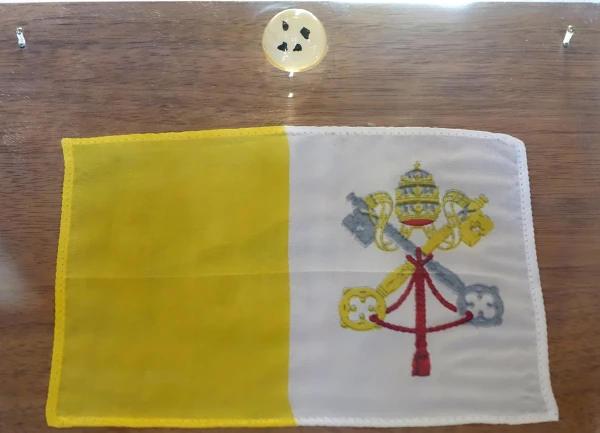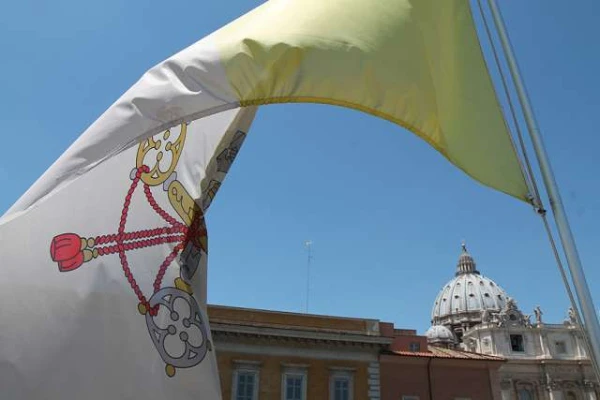CNA Staff, Apr 5, 2025 /
06:00 am
What does the flag of Vatican City look like? What should it look like?
Beyond the recognizable general design of the yellow-and-white flag with the crossed keys on its right side representing the papacy, most Catholics — even if they see this flag displayed every day at their parish — don’t scrutinize the details.
That changed two years ago, when many people learned for the first time — thanks in part to a viral CNA story — that a commonly-used design for the Vatican flag, flown frequently even at the Vatican itself, actually contains a small but easily-noticed error: The circular bottom of the papal tiara should be white, not red, as depicted on many, many flags (oh, and even on emojis).
Given that the image of the “Flag of Vatican City” displayed on Wikipedia from 2017 to 2022 had the erroneous red-tiara design, many people in 2023 deduced that the Wikipedia entry had likely contributed to the proliferation of incorrect flags worldwide. (For better or worse, the CNA story and other news articles contributed to that narrative.)

Father William Becker, a flag expert and pastor at St. Columbanus Parish in Blooming Prairie, Minnesota, told CNA at the time that the variations demonstrated a need for the Vatican to step in and clarify exactly what its flag should look like.
And lo and behold, just months after flag enthusiasts on Reddit discovered the error, Pope Francis promulgated a new Fundamental Law of Vatican City State, which, to Becker’s delight, finally included a high-resolution image and a detailed description of what the flag should look like.
The long and the short of it is that the official design for the flag in the 2023 Fundamental Law does not include the red disk at the bottom of the tiara. The official design for the Vatican City coat of arms, also newly-promulgated along with the flag design, doesn’t have a red disk either.
Case closed? Not quite.
The revelations about the flag and the proliferation of “incorrect” flags sparked a passionate debate online — a debate that raised new questions.
Wikipedia’s fault?
At first, the Vatican flag saga seemed to be a textbook case of “citogenesis” — a term that refers to the manner in which false information can be inadvertently “laundered” after appearing on Wikipedia, especially if authoritative sources such as journalists pick it up.
In this particular case, given that no one noticed that the flag design on Wikipedia was wrong for a period of several years, it seemed likely that many people — including flag makers — assumed it was correct, given how many red-disk flags now exist out in the wild.
Doubts began to stir, however, when users online pointed out numerous examples of older Vatican flags, such as the one Apollo astronauts brought to the moon in 1969, that have the red tiara design as well. A single Reddit user discovered at least four other Vatican flags in his personal collection that feature the red disk and that he says all date to the mid- to late 20th century.

In addition, older pre-internet flag reference books, such as the British Admiralty’s “Flags of All Nations” (1955) depicted the tiara with a red base, potentially influencing flag makers in the U.S. and U.K.
(Story continues below)
Subscribe to our daily newsletter
And in a final, ironic twist, the Vatican itself likely contributed to the confusion nearly two decades ago when it posted this image of its flag, which, head-scratchingly, featured a red disk, despite the 2000 Vatican constitution — which was in force at the time — not featuring one.
So was the infamous Wikipedia edit a cause of the confusion or a symptom?
The obvious solution to the question is to ask the Wikipedia editor why he or she changed the public image file to a red-disk design in the first place. Wikipedia is an anonymous forum, though, which makes such a request tricky.
By a stroke of luck, however, the editor who changed the design in 2017, WikiDan61, shed some light on his decision-making process on the Wikipedia talk page in early 2025.
Perhaps unsurprisingly, WikiDan cited examples of red-disk flags he had seen out in the world — such as this one from 2008 — as the reason he thought the red-disk flag was the correct one.
“To be fair, I did not create the image of the flag with a red interior for the tiara; that image [existed] in the world prior to my creation of the Commons SVG file,” WikiDan61 wrote in response to an interview request from a (non-CNA) journalist. (That journalist created a video essay on the Vatican flag controversy that is well worth watching.)
“It seems even the Vatican itself is not clear on the design of its flag. That being said, I’m not really a very public person, so I would not be interested in discussing this topic off-Wiki,” WikiDan61 concluded.
Origins of the flag
Despite what many people may presume, given the Church’s venerable history, the Vatican flag as we know it today has only represented Vatican City for less than a century. In fact, Vatican City itself is less than a century old — at least in the legal sense of it being its own sovereign country.
For a period of a thousand years, leading up to the late 19th century, the pope was the ruler over the Papal States, large regions mainly within present-day Italy. The Vatican’s 1870 loss of control over the Papal States left it not only geographically tiny but also quite literally surrounded.
The ratification of the Lateran Accords of 1929, 60 years later, finally ushered in harmony between the Vatican and Italy. Vatican City became, and remains, the world’s smallest sovereign country.
In the days of the Papal States, many different flags existed, but the yellow-and-white color scheme was a common feature. First used by the merchant fleet in the Papal States from 1825 to 1870, the design used today was chosen as the new flag of Vatican City in 1929. The same flag chosen in 1929 was reconfirmed in the revised Vatican constitution issued by St. John Paul II in 2000.
In addition to being displayed in most Catholic parishes worldwide, the flag has special significance beyond the walls of Vatican City as a marker for the Vatican’s dozen or so extraterritorial properties, many of which are in Rome. These properties, which include major basilicas such as St. Paul Outside the Walls and St. Mary Major, are marked as belonging to the Vatican through their flying of the papal flag.

Hark the heraldry
So are the variations in the Vatican flag’s exact design out in the world really a big deal?
Jonathan Dixon, a flag expert from Australia who frequently contributes to the subreddit that uncovered the Vatican flag variations, commented to CNA that the idea of an “official design” for a flag is “foreign to the historical use of heraldry and flags.”
“The heraldic tradition has long worked on the idea that the blazon, or verbal/written description of a coat of arms or other heraldic emblem, is what defines it, with a decent amount of variation in how each individual artist depicts it being expected, and treated as a strength rather than a weakness,” Dixon said in written comments to CNA.
“[It’s] a mistake to take every official illustration (such as the one in the Vatican fundamental law) and assume that it’s intended to be treated as something to be precisely replicated.”
For his part, Becker, the Minnesota priest and flag expert, said he considers precise flag standardization a “modern luxury” that some countries — the Vatican included — simply don’t prioritize.
“Actual flags flown at the Vatican have never been very standardized, and there’s no local urge for uniformity,” Becker wrote in an explainer article on the Vatican flag that he shared with CNA.
While flag specialists might regard the design shown in the Vatican’s Fundamental Law as a binding production norm, Becker said Vatican authorities and local flag vendors commonly regard it more as “a general guide.”
That said, while acknowledging the historical variations and Vatican attitudes, Becker said he personally prefers flag standardization — in part to provide reliable guidance for flag makers.
“How much design variation is acceptable in flag production? Vexillologists differ on the matter. I lean toward uniformity over artistic license, because it’s useful for flag makers seeking authoritative guidance for quality control in a global marketplace. At the very least, major reference sources should replicate the Vatican’s constitutional model as an authoritative design guide,” he wrote.
The banner yet waves
It seems clear that the “blame” for all the red-tiara flags is far more difficult to assign than previously thought — and probably ought not be assigned at all.
Since the variations in the Vatican’s flags came to light in 2023, the Vatican has updated its official flag design, which is undoubtedly a significant step. But the persistence of older variations and the absence of rigorous enforcement from the Vatican suggest that a diversity of designs will persist.
Becker noted in an email to CNA that even after the last flag revision in 2000, it took “over a decade” before the adjusted flag model was replicated by a major Italian producer and started appearing at some Vatican sites. Other producers kept using their old templates and still are using them, he said.
“Unless for some reason the Vatican decides to insist on more uniformity from producers and/or those who procure its flags, minor variations will continue as they always have,” Becker said.
Perhaps the bottom line is this: No matter the design quibbles, every Vatican flag serves as a reminder that Jesus Christ’s Church is alive and well here on earth — and that’s significant.
And if you spot a red-tiara design in the wild? It’s a trivial detail, yes, but an oddly satisfying one, and perhaps an opportunity to embrace the complexity and nuance of flag design.
If you know, you know.


















